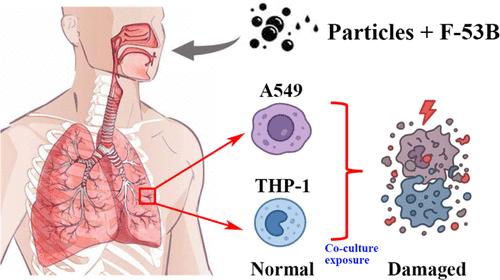大气颗粒中痕量F-53B的毒性影响:对低暴露风险评估的影响
IF 11.3
1区 环境科学与生态学
Q1 ENGINEERING, ENVIRONMENTAL
引用次数: 0
摘要
虽然以前关于F-53B(全氟辛烷磺酸的替代品)的毒理学研究主要采用相对较高的接触剂量,但没有一项研究模拟大气颗粒物(PM)中F-53B的环境相关浓度,以评估其对颗粒引起的毒性的影响。在本研究中,我们通过使用PM2.5吸附的真实F-53B浓度作为设定暴露水平的基础来解决这一差距。使用A549/THP-1共培养模型,对纯碳颗粒作为大气颗粒的替代品,单独和与痕量f - 53b结合的毒理学效应进行了全面评估。尽管其浓度极低,但F-53B显著增强了碳颗粒的毒性,表现为线粒体活性降低、氧化应激升高和细胞周期调节中断。碳颗粒单独抑制大多数炎症和组织修复细胞因子的表达,而F-53B单独适度增加几种促炎介质。联合暴露抑制了F-53B单独引发的一些免疫反应,表明这些污染物之间存在复杂的相互作用。综合效价分析进一步证实,共暴露比单独暴露于碳颗粒造成更大的总体毒性。这些发现突出表明,在评估与大气PM相关的健康风险时,需要考虑F-53B等微量新出现的污染物。本文章由计算机程序翻译,如有差异,请以英文原文为准。

Toxicity Impacts of Trace-Level of F-53B in Atmospheric Particles: Implications for Low-Exposure Risk Assessment
Although previous toxicological studies on F-53B (a substitute for perfluorooctanesulfonic acid) have primarily employed relatively high exposure doses, none have simulated environmentally relevant concentrations of F-53B found in atmospheric particulate matter (PM) to assess its contribution to particle-induced toxicity. In this study, we addressed this gap by using real-world F-53B concentrations adsorbed onto PM2.5 as a basis for setting exposure levels. Pure carbon particles were used as a surrogate for atmospheric particles, and their toxicological effects-alone and in combination with trace-level F-53B-were comprehensively evaluated using an A549/THP-1 coculture model. Despite its extremely low concentration, F-53B significantly amplified the toxicity of carbon particles, as demonstrated by decreased mitochondrial activity, elevated oxidative stress, and disruptions in cell cycle regulation. Carbon particles alone suppressed the expression of most inflammatory and tissue-repair cytokines, while F-53B alone modestly increased several pro-inflammatory mediators. The combined exposure dampened some of the immune responses triggered by F-53B alone, indicating a complex interplay between these pollutants. Integrated potency analyses further confirmed that coexposure resulted in greater overall toxicity than exposure to carbon particles alone. These findings highlight the need to account for trace-level emerging pollutants such as F-53B when assessing the health risks associated with atmospheric PM.
求助全文
通过发布文献求助,成功后即可免费获取论文全文。
去求助
来源期刊

环境科学与技术
环境科学-工程:环境
CiteScore
17.50
自引率
9.60%
发文量
12359
审稿时长
2.8 months
期刊介绍:
Environmental Science & Technology (ES&T) is a co-sponsored academic and technical magazine by the Hubei Provincial Environmental Protection Bureau and the Hubei Provincial Academy of Environmental Sciences.
Environmental Science & Technology (ES&T) holds the status of Chinese core journals, scientific papers source journals of China, Chinese Science Citation Database source journals, and Chinese Academic Journal Comprehensive Evaluation Database source journals. This publication focuses on the academic field of environmental protection, featuring articles related to environmental protection and technical advancements.
 求助内容:
求助内容: 应助结果提醒方式:
应助结果提醒方式:


